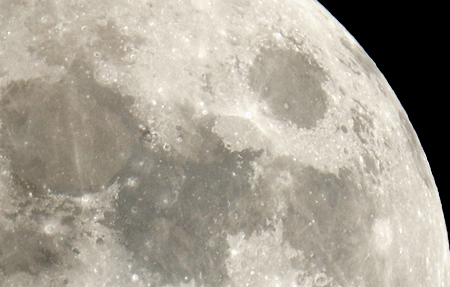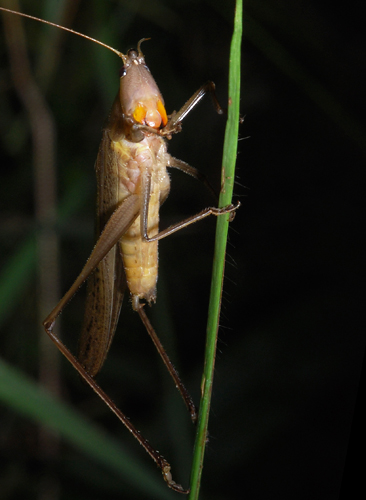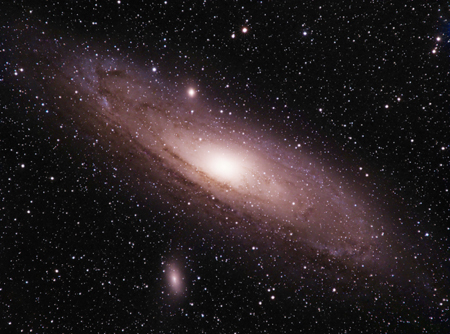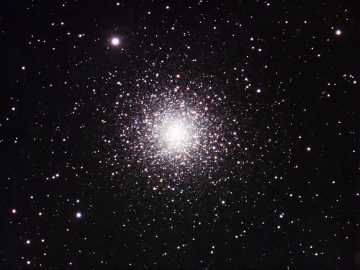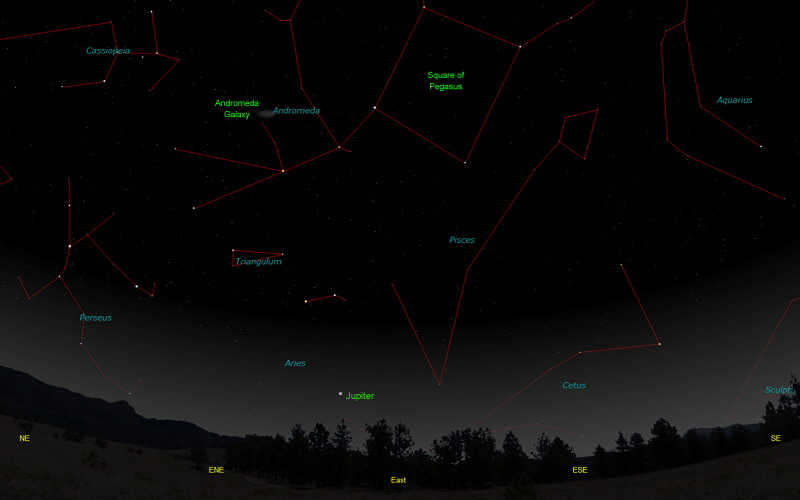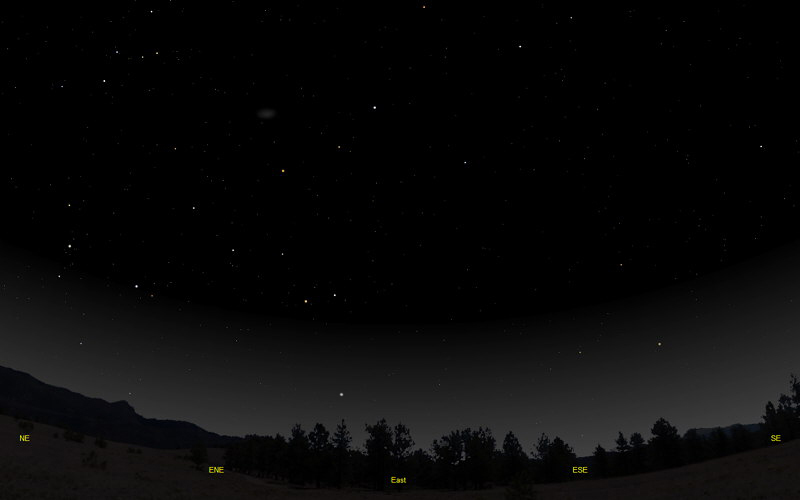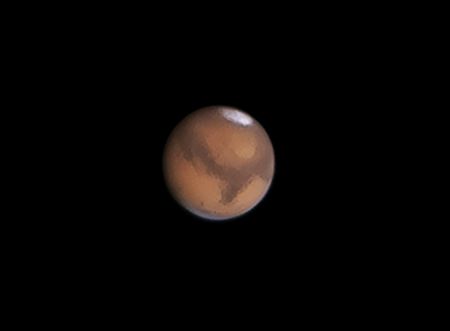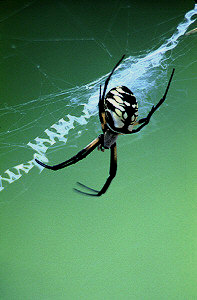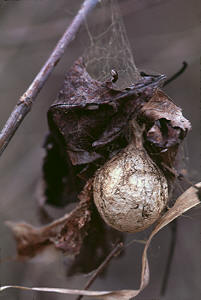The purpose of this feature is to give scout leaders, educators and naturalists an idea of some of the natural events coming up each month. We will try to cover a variety of natural events ranging from sky events to calling periods of amphibians, bird and mammal watching tips, prominent wildflowers and anything else that comes to mind. We will also note prominent constellations appearing over the eastern horizon at mid-evening each month for our area for those who would like to learn the constellations. If you have suggestions for other types of natural information you would like to see added to this calendar, let us know! Note: You can click on the hyperlinks to learn more about some of the featured items. To return to the Calendar, hit the "back" button on your browser, NOT the "back" button on the web page. All charts are available in a "printer friendly" mode, with black stars on a white background. Left clicking on each chart will take you to a printable black and white image. Please note that images on these pages are meant to be displayed at 100%. If your browser zooms into a higher magnification than that, the images may lose quality. Though we link book references to nationwide sources, we encourage you to support your local book store whenever possible. Notes and Images From August 2011
At the end of the first week in August we got a very nice view of two lunar "seas" that are normally difficult to spot. Mare Marginis and Mare Smythii are on the lunar limb in the image at right. Every now and then lunar libration tilts this region toward us, allowing a better view. The image shown was taken a few years back, but offers essentially the same view as what we saw on August 8th. See if you can find "the cat's smile" between Mare Crisium and Mare Marginis in the image, then click the image to see the lunar seas labeled.
One of the later members to join the summer insect orchestra is the Round-tipped Conehead. We have many in our field right now, and the call sounds a little like the Robust Conehead, but is higher, fainter and has a crackling quality to it. You can hear the Robust Conehead call here. If you record one and create a sonogram, you can see that the dominant frequency of the call is about 14 Khz compared to 7 Khz for the Robust Conehead. These coneheads come in both green and brown color phases. The Round-tipped Conehead at left shows the brown phase. Round-tipped Coneheads are much smaller than Robust Coneheads, and at 1-1/2 inches in length they are the smallest member of the conehead family in Tennessee. They should sing throughout September in weedy fields.
Sky Events for September 2011: The Autumnal Equinox, marking the beginning of fall in the Northern Hemisphere, occurs at 4:05 am CDT on September 23rd. Evening Sky: At the beginning of September, Saturn is only about 10 degrees above the western horizon. It will fade into the twilight glow as the month progresses. Jupiter rises in Aries about 9:54pm at the beginning of September. At the very end of the month you may be able to spot Venus in the western sky about 25 minutes after sunset. Binoculars will help you spot it, but start your search only after the Sun is below the horizon. Never look at the Sun with any type of optical instrument. Instantaneous and permanent damage to your eyes can occur. Morning Sky: Mars rises at 2:15am at the beginning of the month in Taurus. Telescopically it is disappointing due to its very small apparent size of 5 seconds-of-an-arc. Look for Mercury at the beginning of the month about 30 minutes before sunrise. It reaches its greatest elongation from the Sun on September 3rd. Spotting the fleet-footed planet takes a flat eastern horizon. Begin your search 30 to 35 minutes before sunrise. Binoculars will enhance your view. The bright star Regulus will be about one binocular field below Mercury on September 3rd. All times noted in the Sky Events are for Franklin, Tennessee and are Central Daylight Time. These times should be pretty close anywhere in the mid-state area. Constellations: The views below show the sky looking east at 9:32pm CDT on September 22nd. The first view shows the sky with the constellations outlined and names depicted. Star and planet names are in green. Constellation names are in blue. The second view shows the same scene without labels. Bright Jupiter dominates the eastern sky in the evenings this month. Pegasus appears higher above the eastern horizon, as does Andromeda. Perseus is above the horizon now, and Cetus is also beginning to appear. The faint stars of Pisces should be easier to pick out this month.
Find the "Square of Pegasus" and work your way outward from it to the constellations around it. See if you can pick out the faint glow of the Andromeda Galaxy, over 2 million light years away! When you look at this galaxy you're seeing light that began its journey to us in the Pleistocene epoch. To get the best look, wait until the galaxy climbs high in the sky. The Andromeda Galaxy was first shown on star charts prepared in 905AD by the Persian astronomer, Al Sufi, and was referred to as the "Little Cloud." That well describes its appearance to the naked eye. Binoculars will greatly improve your view, as will driving out of the city and finding darker skies. Simon Marius, in 1610, was among the first to observe the Andromeda Galaxy through a small telescope. He compared its soft glow to "the light of a candle shining through horn." In dark skies, those using small telescopes may pick out the small satellite galaxies M32 (above and left of the nucleus of M31 in the above image) and NGC 205 (below). A faint tidal bridge connects NGC 205 to Messier 31. Our Milky Way Galaxy and the Andromeda Galaxy are approaching each other and are expected to collide in approximately 4.5 billion years. The two galaxies may merge into a single giant elliptical galaxy at that time.
Another nice September deep sky treat is the globular cluster M15 in Pegasus. In binoculars it looks like a faint little patch of light. You can find it about 4 degrees above the star Enif, which marks the nose of the flying horse. Refer to the star chart for August to better see its position. This globular cluster is about 175 light-years in diameter and about 30,000 light-years away. As with all dark sky objects, you will get a better view when you are as far from city lights as possible, and when the cluster is high in the sky. In a small telescope you may be able to see some of the stars at the edge of the cluster with averted vision.
On Learning the Constellations: We advise learning a few constellations each month, and then following them through the seasons. Once you associate a particular constellation coming over the eastern horizon at a certain time of year, you may start thinking about it like an old friend, looking forward to its arrival each season. The stars in the evening scene above, for instance, will always be in the same place relative to the horizon at the same time and date each September. Of course, the planets do move slowly through the constellations, but with practice you will learn to identify them from their appearance. In particular, learn the brightest stars for they will guide you to the fainter stars. Once you can locate the more prominent constellations, you can "branch out" to other constellations around them. It may take you a little while to get a sense of scale, to translate what you see on the computer screen or what you see on the page of a book to what you see in the sky. Look for patterns, like the stars that make up the "Square of Pegasus." The earth's rotation causes the constellations to appear to
move across the sky just as the sun and the moon appear to do. If you go
outside earlier than the time shown on the charts, the constellations will be
lower to the eastern horizon. If you observe later, they will have climbed
higher. As each season progresses, the earth's motion around the sun causes the constellations to appear a little farther towards the west each night for any given time of night. If you want to see where the constellations in the above figures will be on October 22nd at 9:32pm CDT, you can stay up till 11:32 CDT on September 22nd and get a preview. The westward motion of the constellations is equivalent to two hours per month. Sky & Telescope's Pocket Star Atlas is beautiful, compact star atlas. It is destined to become a classic, and is a joy to use at the telescope. A good book to learn the constellations is Patterns in the Sky, by Hewitt-White. You may also want to check out at H. A. Rey's classic, The Stars, A New Way to See Them. For skywatching tips, an inexpensive good guide is Secrets of Stargazing, by Becky Ramotowski. A good general reference book on astronomy is the Peterson
Field Guide,
A Field Guide to the Stars and Planets, by Pasachoff. The book retails for around $14.00. Starry Night has several software programs for learning the night sky. Visit the Starry Night web site at www.starrynight.com for details.
A Look Back at Mars: In August of 2003 the Earth and Mars approached each other to within about 34,000,000 miles. This was the closest approach of the two planets in 60,000 years. They have been almost that close a number of times in recorded history. Except when it's near opposition, once every 26 months, Mars has a very small telescopic image that shows little detail. Its next opposition is on March 3rd, 2012.
I recently tried out some new planetary image-processing programs on an image of Mars taken on August 9th, 2003. For some reason, I never processed this image before. From a video taken with a small inexpensive web camera, several programs are used to pick the best images in the file, align and stack them, and then sharpen the details. Two things impressed me during the processing. One was how easy these programs are to use. The second was that all of the programs used except the final post-processing program were absolutely free. For a school or amateur astronomer, lunar and planetary imaging is one of the cheapest types of imaging to do. Light pollution is not a problem, and some of the world's best imagers work from highly light-polluted skies. The image above shows the Syrtis Major region of Mars. Some bluish limb clouds are present at the north (bottom in this image) limb of the planet, and a few bluish clouds are present over the dark "V" shaped Syrtis Major region. The south polar cap is subliming and dark fissures can be seen dividing the polar cap.
Amphibians:
The frog and toad choruses start waning in September but some frogs and toads are still calling. Another name for the Spring Peeper is the "Autumn Piper", and these small frogs can be heard calling from patches of woods in the fall. Listen also for a very dry, scratchy version of the Upland Chorus Frog's song on rainy days and nights in September. Southern Leopard Frogs sometimes call and breed as the cooler temperatures mirror their early spring breeding period. You can locate many of the frogs and toads that have been calling more frequently earlier in the year by driving the back roads slowly on rainy nights.
This is a two person job. One person watches the road for amphibians and one person looks out for other vehicles. Anything over about 15mph is "speeding." On wet nights in September, look for breeding Marbled Salamanders in flooded woodland areas. We found one such area where we had previously heard a breeding chorus of Upland Chorus Frogs.
Birds: Fall migration reaches its peak as September progresses. Be sure to check around ponds, river banks and on exposed mud flats for shorebirds, as many pass through Tennessee in the fall. Hawks peak around the third week in September, and you might want to consider a hawk-watching trip. A trip to the banks of the Mississippi River this time of year can yield numerous shorebirds and large flocks of White Pelicans migrating overhead (we saw 58 birds in one flock in the fall of 2001), and Least Terns flying up and down along the river. Recommended: A new guide to hawks in flight you may want to look at is Hawks From Every Angle - How to Identify Raptors in Flight, by Jerry Liguori. The Sibley Guide to Birds, David Allen Sibley The Sibley Guide to Birds of Eastern North America, David Allen Sibley An inexpensive guide for beginners is the Golden Guide for Birds.
Spiders:
Early fall is a great time to observe spiders. One commonly seen spider this time of year is the beautiful Black-and-Yellow Argiope. The body length on the female Argiopes can range up to 1-1/8 inches long. You can sometimes spot the much smaller male Argiope (body length only about 3/8" long) at the edges of the female's web. Black-and-Yellow Argiopes are quite beneficial and feed on a wide variety of flying insects such as aphids, flies, grasshoppers, wasps and bees. Although these spiders may bite when harassed, their venom apparently does not cause problems for humans. Their webs have a characteristic zigzag pattern in the center (see the photo) called the "stabilimenta," so named because it was first thought to provide structural stability for the web.
One competing hypothesis is that the highly visible threads prevent birds from flying through the webs. After mating, the female Black-and-Yellow Argiope produces one or more papery egg sacs. These sacs (Charlotte's "magnum opus" in the book Charlotte's Web, though Charlotte was a Barn Spider) are round and up to an inch in diameter. Each sac contains from 300 to 1400 eggs. The male dies soon after mating, but the females survive until the first hard frost. The young spiderlings hatch in the fall, but overwinter in the sac and do not emerge until the spring. It's interesting to think about them riding out the winter storms in their protective home.
Archives (Remember to use the back button on your browser, NOT the back button on the web page!) Natural Calendar February 2011 Natural Calendar December 2010 Natural Calendar November 2010 Natural Calendar September 2010 Natural Calendar February 2010 Natural Calendar December 2009 Natural Calendar November 2009 Natural Calendar September 2009 Natural Calendar February 2009 Natural Calendar December 2008 Natural Calendar November 2008 Natural Calendar September 2008 Natural Calendar February 2008 Natural Calendar December 2007 Natural Calendar November 2007 Natural Calendar September 2007 Natural Calendar February 2007 Natural Calendar December 2006 Natural Calendar November 2006 Natural Calendar September 2006 Natural Calendar February 2006
Natural Calendar
December 2005
Natural Calendar
November 2005
Natural Calendar
September 2005
Natural Calendar
February 2005
Natural Calendar
December 2004
Natural Calendar
November 2004
Natural Calendar
September 2004
Natural Calendar
February 2004
Natural Calendar
December 2003
Natural Calendar
November 2003
Natural Calendar
September 2003 Natural Calendar February 2003 Natural Calendar December 2002 Natural Calendar November 2002 Nature Notes Archives: Nature Notes was a page we published in 2001 and 2002 containing our observations about everything from the northern lights display of November 2001 to frog and salamander egg masses. Night scenes prepared with The Sky 6 Professional from Software Bisque All images and recordings © 2011 Leaps |
|||||||||||||||||||
